Sheet Music Collection
By Pen Bogert
Reference Specialist
About |
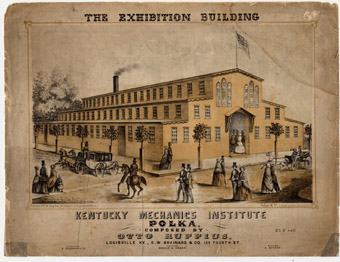 In order to make the collection more accessible to researchers, The Filson is now cataloging the collection,
which will be available through the Online Computer Library Center (OCLC) and our online catalog. At present, over 300
pieces have been cataloged. Researchers may search this collection by composer, arranger, publisher, lithographer, place of publication, topic,
cover illustration and type of music.
In order to make the collection more accessible to researchers, The Filson is now cataloging the collection,
which will be available through the Online Computer Library Center (OCLC) and our online catalog. At present, over 300
pieces have been cataloged. Researchers may search this collection by composer, arranger, publisher, lithographer, place of publication, topic,
cover illustration and type of music.
A collection of this scope enables researchers to study changing tastes in popular music, trends in dance forms, and changes in popularity of types of musical instruments. For example, one can readily see how the polka replaced the mazurka, quadrille and earlier dance forms in the 1840s; how minstrel music grew in popularity in the 1840s and 1850s; the sudden rise in popularity of ragtime in the 1890s; and the popularity of blues by the 1920s.
Since these changing tastes in pop culture also mirror changes in American society, this collection is a wonderful resource for the study of American social history. Who bought sheet music? Only the upper class could attend the balls and cotillions and afford the piano-fortes for which most of the early music was composed, therefore making them the major market for music publishers. The Filson collection includes many bound copies of pieces owned by young music students such as Frances A. Thruston (1826-1896), the daughter of a wealthy Louisville merchant. Her six bound volumes not only show the songs that were popular in the 1830s to 1840s but also introduce us to the elite of this period.
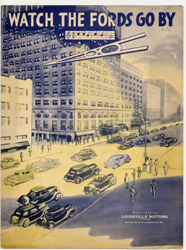 Several pieces were dedicated to her contemporaries – daughters of other wealthy Kentuckians – and include “The Louisville Quadrilles”
(1839), “The Cincinnati Hop Waltz” (1839) and the “Grey Eagle Cotillions” (1840), the latter in honor of the famous horse race
between Grey Eagle and Wagner in 1839. Other pieces, such as “The Drennon Polka Quadrilles” (1849) and “The Paroquet Springs Waltz”
(1843), commemorate Kentucky spas frequented by the elite during the summer months. The latter piece was dedicated to Sally Ward,
the reigning socialite of her era. During the 1840s and 1850s a greater variety of performance venues became available to the general public,
and published vernacular American music, fueled by the wide popularity of minstrel shows, became popular. Songs taken from European and African
American fiddle traditions were in great demand. The great influx of German immigrants in the 1840s helped to popularize both the polka and brass
band music.
Several pieces were dedicated to her contemporaries – daughters of other wealthy Kentuckians – and include “The Louisville Quadrilles”
(1839), “The Cincinnati Hop Waltz” (1839) and the “Grey Eagle Cotillions” (1840), the latter in honor of the famous horse race
between Grey Eagle and Wagner in 1839. Other pieces, such as “The Drennon Polka Quadrilles” (1849) and “The Paroquet Springs Waltz”
(1843), commemorate Kentucky spas frequented by the elite during the summer months. The latter piece was dedicated to Sally Ward,
the reigning socialite of her era. During the 1840s and 1850s a greater variety of performance venues became available to the general public,
and published vernacular American music, fueled by the wide popularity of minstrel shows, became popular. Songs taken from European and African
American fiddle traditions were in great demand. The great influx of German immigrants in the 1840s helped to popularize both the polka and brass
band music.
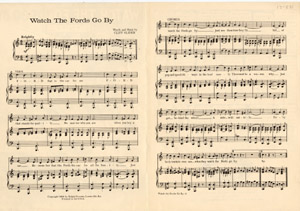 Almost any national or local event and political, social or economic issue became the subject for enterprising composers and publishers. Political
campaigns, exhibitions, funerals of major figures, cities, disasters and changes in transportation were reflected in music. For example, William
Henry Harrison’s presidential campaign was commemorated by “The Log Cabin Quickstep” (1840). The 1853 exhibition in Louisville by the
Kentucky Mechanics Institute was the subject of the “Kentucky Mechanics Institute Polka,” complete with a color lithograph of the exhibition building.
Dozens of songs were published on the funeral of President Lincoln. Tough economic times were reflected in “Money Is A Hard Thing to
Borrow,” sung by the Campbell Minstrels in 1854. Published music not only chronicled military conflicts, but also served to
rally public support for the War With Mexico, the Civil War and later wars and to help the public memorialize these conflicts.
Almost any national or local event and political, social or economic issue became the subject for enterprising composers and publishers. Political
campaigns, exhibitions, funerals of major figures, cities, disasters and changes in transportation were reflected in music. For example, William
Henry Harrison’s presidential campaign was commemorated by “The Log Cabin Quickstep” (1840). The 1853 exhibition in Louisville by the
Kentucky Mechanics Institute was the subject of the “Kentucky Mechanics Institute Polka,” complete with a color lithograph of the exhibition building.
Dozens of songs were published on the funeral of President Lincoln. Tough economic times were reflected in “Money Is A Hard Thing to
Borrow,” sung by the Campbell Minstrels in 1854. Published music not only chronicled military conflicts, but also served to
rally public support for the War With Mexico, the Civil War and later wars and to help the public memorialize these conflicts.
Sheet music, particularly its cover art, reflected the mores and values of society at the time. Subjects as diverse as attitudes towards war, racism, courtship, occupations, material gain and many other topics can be studied at length in this collection. The world of African American composer and cornetist Francis Johnson (“Philadelphia Grays Quick Step”) is juxtaposed against the “Christy Minstrels’ Stop Dat Knocking At My Door” (1847), or compare “The Paroquet Springs Waltz” with its 20th century counterpart, “Kentucky Lake” (“the place for wholesome fun,” 1950). These examples represent just a few possibilities that await persons researching almost any aspect of American history.
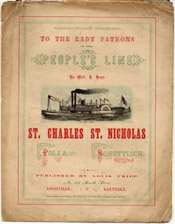
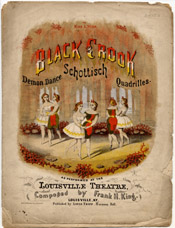
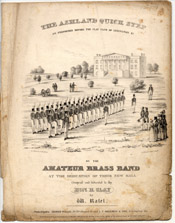
The Filson Historical Society
1310 South Third Street - Louisville, KY
40208
Phone: (502) 635-5083 Fax: (502) 635-5086
Hours
The Ferguson Mansion and Office
Monday - Friday: 9 am. - 5 pm.
Saturday and Sunday closed
Library
Monday - Friday: 9 am. - 5 pm.
Saturday: 9 am. - 12 noon
